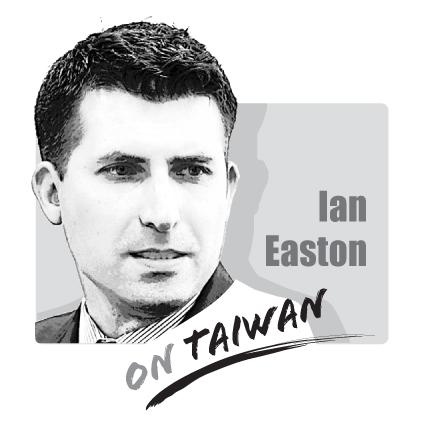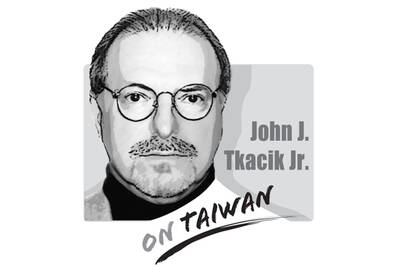China’s growing military power is a source of shared concern in Washington and Taipei. To avoid an enemy attack and the catastrophe of a great power war, the United States and Taiwan should work together to balance against Beijing’s offensive buildup.
It is increasingly clear that Xi Jinping (習近平) has become a brutal dictator. He intends to turn China into a nightmarish surveillance state. To ensure his personal security, Chairman Xi has poured rivers of cash into lethal armaments programs and bizarre science experiments. The same technology used to scan checks on mobile banking apps is now being twisted by China’s secret police to track the faces of human rights lawyers. School children in China are now being fed propaganda amplified by medical-grade brain monitoring devices.
Chairman Xi’s appetite for power has grown with the eating. He wants to dominate the Indo-Pacific region. His ultimate killing machine, the People’s Liberation Army (PLA), is programmed not just to rule China, but also to expand that nation’s borders outward. To achieve his dark vision for the future, Xi seeks to export Beijing’s repressive governance model around the globe, by force when necessary.

The United States and its allies must stay ahead of the armed forces of the Chinese Communist Party (CCP). Human progress and peace will not flourish in a world dominated by China. Yet it will be difficult to guarantee that a dystopian future does not come to pass, first in Taiwan, and then in other once free countries.
ENTER STRATEGIC COMPETITION
For the past two decades, the superpower of democracy has been distracted by terrorist attacks, financial disaster, and dysfunctional leadership. But America has finally woken up to the dangers lurking across the Pacific.
The Pentagon’s 2019 Indo-Pacific Strategy Report states: “The People’s Republic of China, under the leadership of the Chinese Communist Party, seeks to reorder the region to its advantage by leveraging military modernization, influence operations, and predatory economics to coerce other nations.” The report makes clear that China is a revisionist power and America’s main strategic rival.
But what exactly is strategic competition? From the birth of atomic weaponry, contests between great powers have generally been about deterring attacks and preventing conflicts from starting. For rational actors, resorting to war is a strategic failure. When wars do occur, the focus is on keeping them small and limited. Victory is about achieving national aims without putting millions of lives in jeopardy.
Such a victory cannot be taken for granted in the 21st century. It may even prove unlikely. China is a dedicated revanchist, and American military planners know that war is now a real possibility, especially if Chairman Xi makes good on his threats to invade Taiwan. The US military is starting to prepare accordingly. No matter how insane a Taiwan invasion scenario might appear, history shows time and time again that dictators have a way of presenting their more civilized neighbors with “unthinkable” surprises.
If China attacks Taiwan, whatever options the Indo-Pacific Command offered the White House would be unpalatable and fraught with risk. For this reason, the question American strategists will be pondering for years to come is this: How might the US compete and defeat the PLA without drawing blood? That is the essence of strategic competition: to fight and win with latent violence instead of kinetic action.
VICTORY IN THE LONG GAME
What follows is a series of five recommendations on how the US and Taiwan could strengthen their relative security positions and weaken the Chinese military. The immediate aim is to make the PLA a less deadly enemy in war. Even better would be for democracies to win peacefully in a long-term strategic competition.
First, Washington and Taipei should conduct a public relations campaign to attack the legitimacy of the regime in Beijing. This would help private corporations and universities understand why it is unethical and immoral (and increasingly illegal) to allow their technologies and talent to serve the Chinese military-industrial complex. The public message should be that if you cooperate with Beijing, you are selling out. It is critical for democracies to stop aiding the PLA. Instead, they should decouple from and isolate the Chinese military.
Second, exchanges with PLA-affiliated universities, research labs, think tanks, and companies should be put to good use, even as they are in the process of being closed down. When exchanges must occur, they should be seized upon to send clear strategic messages, spread disinformation, and engage in psychological warfare. The Chinese have been exploiting the US and Taiwan this way for decades. The time has come to reciprocate.
Third, the PLA should be forced to make painful budgetary trade-offs. Even China does not have unlimited resources to spend on its military. Programs like the American B-21 penetrating bomber and the Taiwanese HF-2E ground launched cruise missile could force the PLA to invest colossal sums into pricey (and ultimately wasteful) air defense systems. American nuclear attack submarines and Taiwanese indigenous diesel-electric submarines will encourage massive Chinese spending on anti-submarine warfare. This has apparently already started. More is needed.
Fourth, the internal workings of the CCP’s military and civilian bureaucracies should be closely examined. Whenever possible, weaknesses should be exploited to turn factions against each other. This could paralyze effective policy making. Success in this endeavor will require a deep understanding of the target. Research and covert actions will be critical.
Finally, American and Taiwanese strategists must be tough and resilient. The PLA is the armed wing of the CCP. It has the mission of neutralizing any threat to the regime’s expanding grip on regional power. Leaders in Washington and Taipei should be ready to run risks, including the risks associated with US ship visits, joint exercises, and troop rotations in Taiwan. The current status quo in US-Taiwan defense relations is neither static, nor sustainable. To stay relevant, it must advance forward.
Competing to defeat the PLA will not be easy. It will demand a long and grueling campaign. Enormous time and treasure will have to be sacrificed. The free world gave liberally to China and ended up creating a totalitarian juggernaut with soaring ambitions. Now we must begin the hard work of stopping the Communist Party in its tracks.
Ian Easton is a research fellow at the Project 2049 Institute and author of The Chinese Invasion Threat: Taiwan’s Defense and American Strategy in Asia (中共攻台大解密).

Somehow, US intelligence identified “the Houthis’ top missile guy” and pinpointed his exact location. At 1348 hours (Washington time), March 15, President Trump’s national security advisor Mike Waltz texted, “positive ID of him walking into his girlfriend’s building.” The unsuspecting Romeo entered. High above, the drone monitoring the building registered a flash. When the smoke cleared, Mr. Waltz texted, “…And it’s now collapsed.” RIP. The star-crossed “top missile guy” had been target number one in the now uproarious US Navy bombing campaign on that Sunday against the Yemeni rebels who have been holding the Red Sea hostage since October 19,
Deflation in China is persisting, raising growing concerns domestically and internationally. Beijing’s stimulus policies introduced in September last year have largely been short-lived in financial markets and negligible in the real economy. Recent data showing disproportionately low bank loan growth relative to the expansion of the money supply suggest the limited effectiveness of the measures. Many have urged the government to take more decisive action, particularly through fiscal expansion, to avoid a deep deflationary spiral akin to Japan’s experience in the early 1990s. While Beijing’s policy choices remain uncertain, questions abound about the possible endgame for the Chinese economy if no decisive
Actress Michelle Yeoh (楊紫瓊) on March 13 posted an Instagram caption after the opening of Tiffany’s Taipei flagship store two days earlier that read: “Thank you Tiffany for inviting us to Taipei China.” We know that Yeoh knows Taipei is in Taiwan, not China, because the caption was posted following comments she made — in English — in which she said: “Thank you to Tiffany for bringing me to Taipei, because I do love this country very much.” Her remarks and the subsequent Instagram caption were reported in Taiwan, in Chinese and English- language media such as Radio Free Asia, and overseas,
China poses a dire threat to Taiwan’s semiconductor industry as it steps up efforts to poach Taiwan’s top chip talent, following the US’ implementation of stringent chip restrictions. Beijing is keen to develop its own semiconductor technologies, leveraging skilled engineers from Taiwan, Europe and other countries to circumvent US restrictions on providing China access to advanced US chips, particularly those used in artificial intelligence applications, as well as other chip technologies and manufacturing equipment. Taiwan has always contended with talent competition from China, but the situation is worsening. The Hsinchu District Prosecutors’ Office on Friday said that China’s ARK Semi and